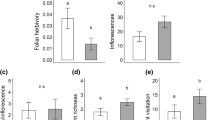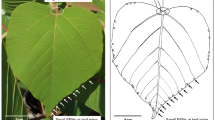Abstract
Plants bearing extrafloral nectaries (EFNs) serve diverse ecological functions by providing nectar to a broad spectrum of arthropods (e.g., ants, parasitoids). This study examined the extent to which plant architecture of American elderberry (Sambucus canadensis L.; Sambucus nigra ssp. canadensis [L.] Bolli), resulting from two pruning methods that produced herbaceous (base-pruning) and woody (high-pruning) stems, and elderberry genotype (nine genotypes were evaluated) influenced ant attendance and arthropod abundance and diversity on elderberry EFNs. Results showed that the proportion of elderberry plants that produced EFNs was significantly greater for the base-pruning compared to the high-pruning method. The positive relationship found between the number of EFN-bearing plants that secreted nectar and ant attendance on EFNs was greater for the base-pruned plants compared to high-pruned plants. Plant genotype also significantly influenced the outcome. When base-pruned, the proportion of plants attended by ants was greatest for the genotypes Ocoee and Marge. The proportion of plants visited by other arthropods (e.g., parasitoids and predators) was greatest for the genotypes Ocoee, Bob Gordon, and Wyldewood. Overall, our findings indicate that the combination of plant genotype selection and selective pruning can modulate insect–plant interactions including mutualistic ant–elderberry associations and visitations by an array of arthropods.






Similar content being viewed by others

References
Alves-Silva E, Del-Claro K (2014) Fire triggers the activity of extrafloral nectaries, but ants fail to protect the plant against herbivores in a neotropic savanna. Arthropod-Plant Int 8:233–240. https://doi.org/10.1007/s11829-014-9301-8
Bentley B (1977) Extrafloral nectaries and protection by pugnacious body guards. Annu Rev Ecol Syst 8:407–427. https://doi.org/10.1146/annurev.es.08.110177.002203
Byers PL, Thomas AL, Millican M (2010) Wyldewood Elderberry. HortSci 45:312–313. https://doi.org/10.21273/HORTSCI.45.2.312
Charlebois D, Byers PL, Finn CE, Thomas AL (2010) Elderberry: botany, horticulture, potential. In: Janick J (ed) Horticulture reviews. Wiley-Blackwell, New Jersey
Finn CE, Thomas AL, Byers PL, Serce S (2008) Evaluation of American (Sambucus canadensis) and European (S. nigra) elderberry genotypes grown in diverse environments and implications for cultivar development. HortSci 43:1385–1391. https://doi.org/10.21273/HORTSCI.43.5.1385
Frost SW (1977) Insects associated with the extrafloral nectaries of elderberry. Fla Entomol 60:186. https://doi.org/10.2307/3493902
Gentry G (2003) Multiple parasitoid visitors to the extrafloral nectaries of Solanum adherens. Is S. adherens an insectary plant? Basic Appl Ecol 4:405–411. https://doi.org/10.1078/1439-1791-00189
Heil M (2004) Induction of two indirect defences benefits Lima bean (Phaseolus lunatus, Fabaceae) in nature. J Ecol 92:527–536. https://doi.org/10.1111/j.0022-0477.2004.00890.x
Heil M (2009) Damaged-self recognition in plant herbivore defence. Trends Plant Sci 14:356–363. https://doi.org/10.1016/j.tplants.2009.04.002
Heil M (2011) Nectar: generation, regulation and ecological functions. Trends Plant Sci 16:191–200. https://doi.org/10.1016/j.tplants.2011.01.003
Heil M (2015) Extrafloral nectar at the plant-insect interface: a spotlight on chemical ecology, phenotypic plasticity, and food webs. Annu Rev Entomol 60:213–231. https://doi.org/10.1146/annurev-ento-010814-020753
Heil M, Fiala B, Baumann B, Linsenmair KE (2000) Temporal, spatial and biotic variations in extrafloral nectar secretion by Macaranga tanarius. Funct Ecol 14:749–757. https://doi.org/10.1046/j.1365-2435.2000.00480.x
Holland JN, Chamberlain SA, Horn KC (2010) Temporal variation in extrafloral nectar secretion by reproductive tissues of the senita cactus, Pachycereus schottii (Cactaceae), in the Sonoran Desert of Mexico. J Arid Environ 74:712–714. https://doi.org/10.1016/j.jaridenv.2009.10.008
Jones IM, Koptur S (2015) Dynamic extrafloral nectar production: the timing of leaf damage affects the defense response in Senna mexicana var. Chapmanii (Fabaceae). Am J Bot 102:58–66. https://doi.org/10.3732/ajb.140038
Koptur S (1984) Experimental evidence of Inga (Mimosoideae) saplings by ants. Ecology 65:1787–1793. https://doi.org/10.2307/1937775
Koptur S (1992) Plants with extrafloral nectaries and ants in everglades habitats. Fla Entomol 71:38–50. https://doi.org/10.2307/3495479
Koptur S, Palacios-Rios M, Diaz-Castelazo C, Mackay WP, Rico-Gray V (2013) Nectar secretion on fern fronds associated with lower levels of herbivore damage: field experiments with widespread epiphyte of Mexican cloud forest remnants. Ann Bot 111:1277–1283. https://doi.org/10.1093/aob/mct063
Kost C, Heil M (2005) Increased availability of extrafloral nectar reduces herbivory in Lima bean plants (Phaseolus lunatus, Fabaceae). Basic App Ecol 6:237–248. https://doi.org/10.1016/j.baae.2004.11.002
Lange D, Calixto ES, Del-Claro K (2017) Variation in extrafloral nectary productivity influences the ant foraging. PLoS ONE 12(1):e0169492. https://doi.org/10.1371/journal.pone.0169492
Marazzi B, Bronstein JL, Koptur S (2013) The diversity, ecology and evolution of extrafloral nectaries: current perspectives and future challenges. Ann Bot 111:1243–1250. https://doi.org/10.1093/aob/mct109
Ness JH (2003) Catalpa bignonioides alters extrafloral nectar production after herbivory and attracts ant bodyguards. Oecologia 134:210–218. https://doi.org/10.1007/s00442-002-1110-6
Pemberton RW, Lee J-H (1996) The influence of extrafloral nectaries on parasitism of an insect herbivore. Am J Bot 83:1187–1194. https://doi.org/10.2307/2446203
Piovia-Scott J (2011) The effect of disturbance on an ant-plant mutualism. Oecologia 166:411–420. https://doi.org/10.1007/s00442-010-1851-6
Radhika V, Kost C, Bartram S, Heil M, Boland W (2008) Testing the optimal hypothesis for the indirect defences: extrafloral nectar and volatile organic compounds. Planta 228:449–457. https://doi.org/10.1007/s00425-008-0749-6
Rezende MQ, Venzon M, Perez AL, Cardoso IM, Janssen A (2014) Extrafloral nectaries of associated trees can enhance natural pest control. Agric Ecosyst Environ 188:198–203. https://doi.org/10.1016/j.agee.2014.02.024
Rudgers JA, Gardener MC (2004) Extrafloral nectar as a resource mediating multispecies interactions. Ecology 85:1495–1502. https://doi.org/10.1890/03-0391
Thomas AL, Byers PL, Ellersieck MR (2009) Productivity and characteristics of American elderberry in response to various pruning methods. HortSci 44:671–677. https://doi.org/10.21273/HORTSCI.44.3.671
Wackers FL, Bonifay C (2004) How to be sweet? Extrafloral nectar allocation by Gossypium hirsutum fits optimal defense theory predictions. Ecology 85:1512–1518. https://doi.org/10.1890/03-0422
Wang Y, Carrillo J, Siemann E, Wheeler GS, Zhu L, Gu X, Ding J (2013) Specificity of extrafloral nectar induction by herbivores differs among native and invasive populations of tallow tree. Ann Bot 112:751–756. https://doi.org/10.1093/aob/mct129
Acknowledgements
The authors thank Jason Miller (JM), Jacob Wilson, Austen Dudenhoeffer (AD), and Dinesh Panday (Lincoln University) for assisting with data collection. We would also like to thank DeMarco Bernice (Michigan State University) and Luc Leblanc (University of Idaho) for the identification of ant and wasp specimens collected from the field trial. We are grateful to two anonymous reviewers and to JM and AD for valuable comments on an earlier version of this manuscript. This work was supported by the USDA National Institute of Food and Agriculture, Evans-Allen project Accession no. 233899 (https://nifa.usda.gov/program/agricultural-research-1890-land-grant-institutions). The funders had no role in study design, data collection and analysis, decision to publish, or preparation of the manuscript.
Author information
Authors and Affiliations
Contributions
Conceived and designed the experiments: JCP RM. Performed the experiments: RM. Analyzed the data: RM. Contributed reagents/materials/analysis tools: JCP. Wrote the paper: RM JCP.
Corresponding author
Additional information
Handling Editor: Jouni Sorvari.
Publisher's Note
Springer Nature remains neutral with regard to jurisdictional claims in published maps and institutional affiliations.
Rights and permissions
About this article
Cite this article
Piñero, J.C., Manandhar, R. Ant attendance and arthropod diversity on elderberry extrafloral nectaries are influenced by plant genotype and pruning method. Arthropod-Plant Interactions 14, 595–604 (2020). https://doi.org/10.1007/s11829-020-09771-8
Received:
Accepted:
Published:
Issue Date:
DOI: https://doi.org/10.1007/s11829-020-09771-8



